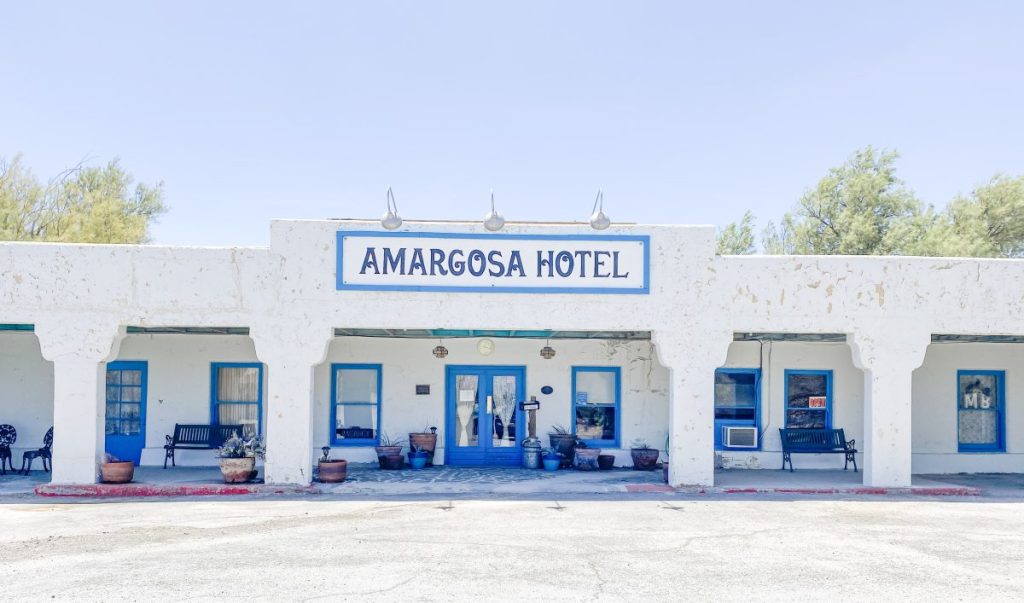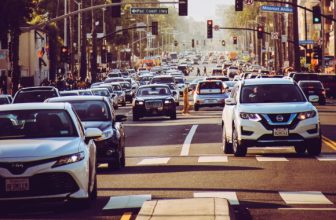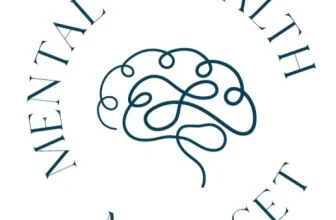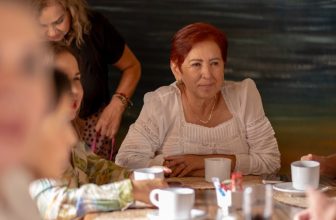
This post may contain affiliate links. Please read our disclosure policy for more information.
At first glance, the title of this post probably seems a little crazy. Why would you go to Death Valley National Park in July? If you’re a teacher and you have a school-age kid, this stop along a massive road trip makes perfect sense. In 2022, we set out from Joplin, Missouri, to undertake one of our longest road trips to date. A couple of days before, we’d stopped overnight along the highway, and we’d also spent a night at Grand Canyon National Park at Kachina Lodge.
Our next overnight stop was scheduled for Lone Pine, California. Along the way, we hoped to spend some time in Death Valley National Park, even though it was so hot we didn’t want to leave our car for very long.
Visiting in July is possible, but I wouldn’t plan on any major hiking during the day. Be sure to have plenty of water with you. Since we were roadtrippin’ it, we had our cooler fully stocked.
We left our room at Kachina Lodge in the Grand Canyon Village about an hour after sunrise. To read more about our night there, click here. We made a couple of stops along the way, but not for long. We had one thing on our minds–getting to Death Valley National Park. We even drove parallel to Las Vegas and saw its wonders from a distance. It was tempting, but we remained dedicated to our mission.
After about 6 hours, we found ourselves at Death Valley Junction, a little place (statistics state the population is under 20) right outside the park. This tiny community is famous for two things–a lucrative history of borax mining and the Amargosa Hotel and Opera House.
Amargosa Hotel and Opera House
In 1925, the building that would become the Amargosa Hotel was completed in Death Valley Junction. Its initial purpose was to house the businessmen who came to the borax mines. After the mine closed in 1928, the building officially became a hotel for travelers.
The hotel was pretty fancy for its time. It had central air conditioning, which had to be a relief for those traveling in this unrelenting desert. One of those travelers, Marta Becket, would impact the area for years to come.
In 1967, Marta and her husband had a flat tire, and they stopped at the gas station in Death Valley Junction for repairs. While there, Marta explored the community and discovered the opera house. Because she was a ballet dancer and painter, Marta was inspired to make the opera house her own. The Beckets decided to rent the opera house, and later that year, they officially moved in.

After some renovations, the opera house was ready and Marta started performing in 1968. Sometime during that same year, the opera house flooded. As she worked to repair the damage, inspiration struck again. This time, she decided to paint an audience on the walls of the house.
Marta also used the walls of the lobby and rooms in the hotel as her canvas. While you can’t see the guest rooms unless you’re staying there or on a tour, you can stop by and take a look in the lobby.
Notice Marta Becket’s portrait above the fireplace.

Marta’s work adds character to the place, and her legacy certainly carries on. She performed and painted up until 2012, though in later years, she sat on a chair and moved her feet to dance. She died at the age of 92 in 2017. Today, the opera house hosts an anniversary performance every February to commemorate the opera house’s opening.

Guests of the hotel and opera house are said to have included Ray Bradbury and Red Skelton in its heyday. Today, the place is considered haunted, and the paranormal investigation show Ghost Adventures has filmed there. To read more about this fascinating place, click here.
Entering Death Valley National Park
After a brief stop at Amargosa Hotel and Opera House, we made our way on down the highway towards Death Valley National Park. Our main goal was to get to the Furnace Creek Visitor Center and then check out a few sights in the area.

This is the view from the eastern entrance of the park. We were the only car on this side of the park at the time. The scenery is beautiful; you also get the sense of just how vast the park is and the undeniable feeling of aloneness.

Furnace Creek Visitor Center
Soon, we made it to Furnace Creek Visitor Center to get the highly coveted photo opp. There were a couple of other parties in this area taking turns for the picture. It is so hot, though. You want to take it in a hurry and then get inside the building in the summer.
One thing that’s nice is that the visitor center offers some covered parking. Not every spot, but enough to accommodate the current visitors most days. I’m sure. Every bit of shade helps.

You’ll find some educational displays about the desert inside the visitor center. You’ll also find the gift shop and park rangers, much like other national parks. If you’re lucky, you might also have the opportunity to purchase bottled water with the Death Valley National Park logo on it.

After a cool down, we forced ourselves back outside and made a beeline for the car. We had some ideas about some of the highlights we’d like to check out before heading on to Lone Pine.
As you drive around, you definitely get this “other worldly” vibe. It’s easy to see why films are made in the area.
Here’s a list of some of the movies (in no particular order) that were at least partially filmed in Death Valley:
Star Wars: A New Hope (1977) for Tatooine
Star Wars: Return of the Jedi (1983) for Jabba’s Palace backdrops
Raiders of the Lost Ark (1981)
3 Godfathers (1948) John Ford film starring John Wayne
The Hitcher (1986)
The Twilight Zone (1959-1961) TV series: three episodes
Yellow Sky (1949) starring Gregory Peck and Anne Baxter
One-Eyed Jacks (1961) starring Marlon Brando
National Lampoon’s Vacation (1983)
The Doors (1991)
The Greatest Story Ever Told (1965)
There are many, many more. Also, a lot of films utilized the area of Lone Pine, California, where we stayed for a night following our Death Valley National Park adventure. There is also a great film museum in Lone Pine. I will write more about those soon.

We decided to head south on Highway 178, a main road through the park, to catch a glimpse of Devils Golf Course. On the way, we passed The Oasis at Death Valley, a resort planted in the desert in 1927. Apparently, Hollywood stars used to escape here, which makes sense when you know how many films were shot in the general area. Though the luxury and elegance have been maintained, I still can’t get past how hot it is here in July. If planning a summer stay, I can’t imagine that you’d go outside during the day.

Devils Golf Course
After driving a little more, we found our next destination–Devils Golf Course.

The bumpy terrain is so unique. You have to walk around on it to truly appreciate it.

The holes pointing every which way would not make for a fun golf day.

From Devils Golf Course, it’s a short drive over to the Artist Drive and Artist Palette area.

The Black Mountains create a gorgeous backdrop.

Here is another shot of the emptiness of the park. Of course, it is mid-summer.

The highways seem to stretch into oblivion.
Artists Drive and Artists Palette
Artists Drive is a one-way nine-mile loop road that takes you through some features with some color on them, hence the name Artists Palette. Before the loop road’s turnoff, we encountered a pull-off area that some other people were exploring. Since it was rare to see other people in the park at this time, we thought it would be worth checking out. If it’s good enough for them, it’s good enough for us.

Have I mentioned it was hot? It was so hot that we made the trek up the embankment as quickly as possible. It felt like the sun was trying to kill us.
The picture below shows the view from the top looking back at our vehicles. I suppose we were looking at the beautiful mountain views. You’re pretty much surrounded by these mountains in Death Valley.
I’m not sure what we scrambled up the embankment to see, but I do remember being covered in sweat afterward. I guess that was a good thing; we weren’t having a heat stroke, at least.

We then took the loop road up Artists Hill and through the Artists Palette area. The colors at 4:00 p.m. are subtle but pretty. Apparently, at dusk and sunset, the colors are more vibrant. The green color is supposed to be from mica and volcanic ash. Iron and manganese add the red, yellow, and purple touches.

Mesquite Flat Sand Dunes
After we made the loop, we felt we should probably make our way out of the park and towards Lone Pine. Along the way, we passed the Mesquite Flat Sand Dunes. So pretty.

Before making the journey on to Lone Pine, we stopped at the Stovepipe Wells General Store to look around. We also saw people swimming at the Stovepipe Wells Village Hotel. That is another option for lodging in Death Valley.
The route we took to Lone Pine quickly became a journey upward as we drove up into the edges of what must have been part of the Panamint Range. It was one of those tedious treks, but we finally made it out of the mountains.
Places We Missed
Of course, we only scratched the surface of Death Valley National Park, and that surface was like the surface of the sun. If you are there during another season, you can probably enjoy some of the more remote areas and some of the hiking trails. It was simply to hot for us. Every year, someone dies due to heat-related reasons in Death Valley. It’s extremely important to be water-aware and to limit your time in the heat during the summer months.
Here are some places I’d like to see if I ever get to return:
Badwater Basin: This is a salt flat, and it’s the lowest elevation in North America. There is a small spring-fed pool here, but it’s high in salt content. Hence the “badwater” part. It looks like a fun place to explore. We’ve been to the Bonneville Salt Flats in Utah. Click here to read more about that adventure.
Racetrack Playa: This is an area where rocks seemingly move by themselves. Apparently, several factors merge to create this phenomenon–rocks fall down the mountain, a thin layer of ice forms after it rains, and strong winds push the rocks across the barren landscape, with the rocks leaving a trail behind them as evidence of the movement. Sounds fascinating!
Zabriskie Point: This is a popular place for watching the sunrise or sunset. This point offers a panoramic view of Death Valley. Luckily, you can drive and park at the point.
Dante’s View: This is another popular place for sunrise and sunset. You also get a panoramic view and great photo opportunities for the Black and Panamint Mountains. You’ll also get an aerial view of Badwater Basin. It’s also drivable!
Ubehebe Crater: This is a volcanic crater at the northern end of the park. You can drive to it, but it’s a remote one, so you’ll have to carve out some time to see it.
Rainbow Canyon: Jeff would probably agree with the title of Star Wars Canyon for this one, though Star Wars wasn’t filmed here; it’s an honorary name. You may be able to catch military jets in training here if you luck out on a training day. Pilots get to perfect their low-lying flying skills in the canyon.
Panamint Valley: This valley includes a ghost town now known as a hiking destination. There is also a radar station and Charles Manson’s last hideout in the valley.
Wildrose Charcoal Kilns: These are historic kilns built in Wildrose Canyon in 1877. To refine ore, a fuel that would burn slow and hot was needed; charcoal provided that fuel. It’s believed the kilns were only used a couple of years, but you can still see them today.
The Wrap-Up
Death Valley National Park is one of the most unique places we’ve been. I’m glad we got to explore the area, even if it was summer and extremely hot. I hope we have a chance to visit again so we can at least see some of the places we missed. The memories we made in Death Valley will always be among my favorites.

Click on the links below to read about some of our other adventures on this road trip!
Manzanar National Historic Site–Lone Pine, California
Sequoia and Kings Canyon National Parks
Winchester Mystery House–San Jose, California








